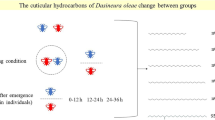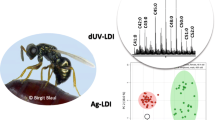Abstract
Cuticular hydrocarbons (CHCs) are important, multi-function components of the insect epicuticle. In Drosophila spp., CHCs provide protection from desiccation and serve as semiochemicals for both intra- and interspecific communication. We developed a non-lethal method for the modification of Drosophila CHCs profiles through the exposure of live insects to a high dose of ozone gas (~ 45,000 ppm). Drosophila suzukii that were treated with ozone showed a 1.63–3.10 fold reduction in unsaturated hydrocarbons with these CHCs shown to regenerate over 108 h. Changes in CHCs were correlated with significantly reduced desiccation resistance in both male and female D. suzukii at one h after ozone treatment. Interestingly, individuals treated with ozone showed increased desiccation resistance in comparison to controls at 108 h after ozone treatment. The methodology reported in this paper provides a novel approach to investigate the biosynthesis and functions of CHCs during the lifespan of an insect.







Similar content being viewed by others
Data Availability
Available upon request.
Code Availability
Available upon request.
Change history
05 July 2021
Table 2 last 2 column were corrected due to misalignment of entries.
References
Antony C, Davis TL, Carlson DA et al (1985) Compared behavioral responses of maleDrosophila melanogaster (Canton S) to natural and synthetic aphrodisiacs. J Chem Ecol 11:1617–1629. https://doi.org/10.1007/BF01012116
Asplen MK, Anfora G, Biondi A et al (2015) Invasion biology of spotted wing Drosophila (Drosophila suzukii): a global perspective and future priorities. J Pest Sci 88:469–494. https://doi.org/10.1007/s10340-015-0681-z
Bartelt RJ, Armold MT, Schaner AM, Jackson LL (1986) Comparative analysis of cuticular hydrocarbons in the Drosophila virilis species group. Comp Biochem Physiol Part B Comp Biochem 83:731–742. https://doi.org/10.1016/0305-0491(86)90138-0
Bartelt RJ, Jones RL, Kulman HM (1982) Hydrocarbon components of the yellowheaded spruce sawfly sex pheromone. J Chem Ecol 8:95–114. https://doi.org/10.1007/BF00984008
Beroza M, Bierl BA (1967) Rapid determination of olefin position in organic compounds in microgram range by ozonolysis and gas chromatography. Alkylidene Analysis Anal Chem 39:1131–1135. https://doi.org/10.1021/ac60254a038
Billeter J-C, Atallah J, Krupp JJ et al (2009) Specialized cells tag sexual and species identity in Drosophila melanogaster. Nature 461:987–991. https://doi.org/10.1038/nature08495
Blomquist GJ, Bagnères A-G (2010) Insect Hydrocarbons: Biology, Biochemistry, and Chemical Ecology. Cambridge University Press
Bolda MP, Goodhue RE, Zalom FG (2010) Spotted Wing Drosophila: Potential Economic Impact of a Newly Pest. Agricultural Resource Economics. Update, University of California Giannini Foundation of Agricultural Economics 13:5–8
Chung H, Carroll SB (2015) Wax, sex and the origin of species: Dual roles of insect cuticular hydrocarbons in adaptation and mating. BioEssays 37:822–830. https://doi.org/10.1002/bies.201500014
Crawley MJ (2007) The R Book. John Wiley & Sons
Dalton DT, Walton VM, Shearer PW et al (2011) Laboratory survival of Drosophila suzukii under simulated winter conditions of the Pacific Northwest and seasonal field trapping in five primary regions of small and stone fruit production in the United States. Pest Manag Sci 67:1368–1374. https://doi.org/10.1002/ps.2280
Dekker T, Revadi S, Mansourian S, et al (2015) Loss of Drosophila pheromone reverses its role in sexual communication in Drosophila suzukii. Proc R Soc B Biol Sci 282:. https://doi.org/10.1098/rspb.2014.3018
Erdman HE, Hernandez T (1982) Adult toxicity and dominant lethals induced by ozone at specific stages in spermatogenesis in drosophila virilis. Environ Mutagen 4:657–666. https://doi.org/10.1002/em.2860040605
Ferveur J-F (1997) The pheromonal role of cuticular hydrocarbons in Drosophila melanogaster. BioEssays 19:353–358. https://doi.org/10.1002/bies.950190413
Ferveur J-F (2005) Cuticular Hydrocarbons: Their Evolution and Rolesin Drosophila Pheromonal Communication. Behav Genet 35:279. https://doi.org/10.1007/s10519-005-3220-5
Folk DG, Christine H, Timothy JB (2001) Water acquisition and partitioning in : effects of selection for desiccation-resistance. J Exp Biol 204(19):3323–3331
Gibbs A, Pomonis JG (1995) Physical properties of insect cuticular hydrocarbons: The effects of chain length, methyl-branching and unsaturation. Comp Biochem Physiol B Biochem Mol Biol 112:243–249. https://doi.org/10.1016/0305-0491(95)00081-X
Gibbs AG (1998) Water-Proofing Properties of Cuticular Lipids. Integr Comp Biol 38:471–482. https://doi.org/10.1093/icb/38.3.471
Gibbs AG (2002) Lipid melting and cuticular permeability: new insights into an old problem J. Insect Physiol 48:391–400. https://doi.org/10.1016/S0022-1910(02)00059-8
Hadley NF (1994) Ventilatory Patterns and Respiratory Transpiration in Adult Terrestrial Insects. Physiol Zool 67:175–189. https://doi.org/10.1086/physzool.67.1.30163841
Howard RW, Blomquist GJ (2005) Ecological, Behavioral, and Biochemical Aspects of Insect Hydrocarbons. Annu Rev Entomol 50:371–393. https://doi.org/10.1146/annurev.ento.50.071803.130359
Howard RW, Jackson LL, Banse H, Blows MW (2003) Cuticular Hydrocarbons of Drosophila birchii and D. serrata: Identification and Role in Mate Choice in D. serrata. J Chem Ecol 29:961–976. https://doi.org/10.1023/A:1022992002239
Jallon J-M, David JR (1987) Variation in Cuticular Hydrocarbons Among the Eight Species of the Drosophila melanogaster Subgroup. Evolution 41:294–302. https://doi.org/10.2307/2409139
Moreira LH, Figueiredo TFB, Alves LP et al (2018) Effect of Ozone as Acaricide: Action of the Ozone on the Cuticle and Respiratory Spiracle of Tick Rhipicephalus sanguineus sensu lato. Ozone Sci Eng 40:183–190. https://doi.org/10.1080/01919512.2017.1403306
Ortiz-Urquiza A, Keyhani NO (2013) Action on the Surface: Entomopathogenic Fungi versus the Insect Cuticle. Insects 4:357–374. https://doi.org/10.3390/insects4030357
Qiu Y, Tittiger C, Wicker-Thomas C et al (2012) An insect-specific P450 oxidative decarbonylase for cuticular hydrocarbon biosynthesis. Proc Natl Acad Sci 109:14858–14863. https://doi.org/10.1073/pnas.1208650109
Quinlan MC, Hadley NF (1993) Gas Exchange, Ventilatory Patterns, and Water Loss in Two Lubber Grasshoppers: Quantifying Cuticular and Respiratory Transpiration. Physiol Zool 66:628–642. https://doi.org/10.1086/physzool.66.4.30163812
R Core Team (2015) R: A language and environment for statistical computing. R Foundation for Statistical Computing, Vienna, Autria
Ramsay JA (1935) The Evaporation of Water from the Cockroach. J Exp Biol 12:373–383
Rich JT, Neely JG, Paniello RC et al (2010) A Practical Guide To Understanding Kaplan-Meier Curves. Otolaryngol-Head Neck Surg off J Am Acad Otolaryngol-Head Neck Surg 143:331–336. https://doi.org/10.1016/j.otohns.2010.05.007
Savage BA (2020) Exploring The Insecticidal Potential Of Aqueous And Gaseous Ozone Using Spotted Wing Drosophila. Michigan State University, Drosophila suzukii (Matsumura) (Diptera-drosophilidae) As A Model Organism
Snellings Y, Herrera B, Wildemann B et al (2018) The role of cuticular hydrocarbons in mate recognition in Drosophila suzukii. Sci Rep 8:4996. https://doi.org/10.1038/s41598-018-23189-6
Sousa AH, Faroni LRD, Guedes RNC et al (2008) Ozone as a management alternative against phosphine-resistant insect pests of stored products. J Stored Prod Res 44:379–385. https://doi.org/10.1016/j.jspr.2008.06.003
Therneau T (2021). A Package for Survival Analysis in R. R package version 3.2–11. https://CRAN.R-project.org/package=survival
Toolson EC, Kuper-Simbron R (1989) Laboratory Evolution of Epicuticular Hydrocarbon Composition and Cuticular Permeability in Drosophila pseudoobscura: Effects on Sexual Dimorphism and Thermal-Acclimation Ability. Evolution 43:468–473. https://doi.org/10.2307/2409222
Waters (2020) MassLynx MS Software. In: Waters. https://www.waters.com/waters/en_US/MassLynx-MS-Software/nav.htm?cid=513662&locale=en_US. Accessed 1 Apr 2020
Acknowledgements
Experiments were made possible with the help of Allison Fischer, Charlotte Schuttler, Elizabeth Szcepanski, Kyle Akred, Keith Koonter, Juan Huang, Ph.D., and Phil Fanning, Ph.D. Experiments were performed at the Organic Pest Management lab at Michigan State University directed by Matthew Grieshop, Ph.D.
Funding
Organic Pest Management lab of the Entomology Department at Michigan State University.
Author information
Authors and Affiliations
Contributions
Benjamin Savage designed experiments, executed experiments, collected data, performed statistical analysis, wrote code for statistical analysis, developed figures, and wrote the article.
Zinan Wang provided methodological support for cuticular extractions, GC/MS set-up, and developed figures.
Susan Masten provided ozone concentration measurement equipment and scientific advice.
Henry Chung provided experimental design support.
Matthew Grieshop provided scientific leadership, equipment, and funding.
Corresponding author
Ethics declarations
Conflicts of interest/Competing interests
NA
Supplementary Information
Below is the link to the electronic supplementary material.
Rights and permissions
About this article
Cite this article
Savage, B., Wang, Z., Chung, H. et al. An Ozonolysis Based Method and Applications for the Non-Lethal Modification of Insect Cuticular Hydrocarbons. J Chem Ecol 47, 628–641 (2021). https://doi.org/10.1007/s10886-021-01285-8
Received:
Revised:
Accepted:
Published:
Issue Date:
DOI: https://doi.org/10.1007/s10886-021-01285-8




